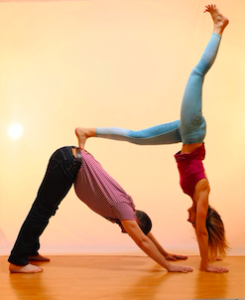Exercise during pregnancy improves general health, vitality, and wellbeing, and reduces stress. However, some safety precautions are necessary for the exercise during the pregnancy period. Yoga is a popular form of exercise among pregnant women.
We are delighted to publish this guest blog written by Anja Brierley Lange. In this article, Anja provides very useful information on some yoga poses pregnant women should avoid.

About the author
Anja is the founder of Yoga Embodied and Soma Aroma. Here she shares her passion for holistic health and wellbeing. Her approach is elective having qualifications and experience in Ayurvedic medicine (BSc, PGDip), yoga, clinical aromatherapy, flower essences amongst others.
Her specialty is in working with women to facilitate space to create healing, and empower women to feel confident and balanced with their menstrual cycle, feminine health, pelvic awareness as well as during pregnancy and postpartum.
She created the online prenatal yoga course to support women with accessible and short yoga sessions designed to be added together for longer sessions when time allows.
As one of the pillars of health in Ayurveda is our digestion and mental/emotional health Anja has a strong passion for both. It is all about balance: Aside from her continuous study and research Anja loves reading, writing and has a love for sweet and beautiful cakes.

Yoga Poses You Shouldn’t Do Whilst Pregnant
While yoga is a wonderful practice during pregnancy with many benefits specifically for the pregnant body there are also a few things to be aware of. Whether you are new to yoga or a seasoned practitioner your relaxin levels have increased making your ligaments more “relaxed” and stretchy.
This can cause overstretching leading to injury and something you need to be mindful of. Other hormonal changes, as well as increased blood volume, are also important factors when it comes to your yoga practice. Then the obvious signs of a growing bump and breasts which we want to accommodate.
Enjoy practices in a normally temperate environment. Avoid hot yoga. Pregnant women generally feel hotter due to the changes hormonally, the heat generated by baby and increased blood volume. There is no need to increase this by practicing yoga in a hot room rather stay cool near a door or window so you don’t dehydrate or get too flustered.
Always enjoy specific prenatal classes with an experienced qualified pregnancy teacher – even as an experienced yogini!
Enjoy your practice but avoid the following:
1) Deep backbends such as wheel pose.
Although opening the front body feels wonderful and offers a feeling of joy and lightness be aware of two things: Compression in the lower back. This can pinch the nerves, give a backache and potentially attribute to sciatica and pelvic girdle pain. The other issue is overstretching the abdomen. Too much stretching at the front might contribute to diastasis recti or abdominal separation.

2) Crunches like crow pose.
We might not do sit-ups in yoga but many poses compress the abdomen. Poses such as certain plank pose variations, knee to chest poses and crow pose utilises the abdominal muscles to coil inwards.
Like the deep backbends, this actually creates a strain on the linea alba potentially causing diastatic recti (abdominal separation). This it is due to excess internal pressure. Not just your growing baby and uterus but also the action of the abdominal muscles. In pregnancy, you want to create space for your body and your babies to grow.
Any pressure on the abdomen is the opposite and in a pregnant or immediate postpartum body, there are no benefits to crunching!

3) Inversions.
Now if you are an experienced yogini practicing daily inversion such as headstand and handstand you may want guidance on this one. In Iyengar yoga, these poses can still be part of a regular practice for women with an established practice and practiced with a teacher. But just because you can doesn’t mean you should. And certainly, these are not poses for new yogis.
When in a headstand there is immense pressure on the cervical spine, the neck. With the high level of relaxin, and the changes to your centre of gravity and balance this can cause neck issues. Also, consider that the blood volume has increased in your pregnancy and being inverted might bring to much circulation to your head.
These poses require strong deep core and pelvic floor engagement. Although pelvic floor awareness is important in pregnancy using deep core including the pelvis to stabilise an inversion is excessive.

4) Prone poses e.g. lying on your front.
Lying on the belly will soon become uncomfortable. The pressure on bump and breasts uncomfortable it is a pose soon avoided for its discomfort. Plus it also compresses the abdominal area and your bump.
Many prone poses can be substituted by hands-and-knees/all four variations.

5) Compression of the abdomen and bump.
Whether it’s a deep forward bend or a closed twist start to think of creating space. Space for babies, for your breath, your digestion and for your body.
Rather than twisting across your bend knee twist in the opposite direction or create more space. Instead of bending over your legs create spaciousness by separating your legs and never fold all the way. Embrace the use of chairs or plenty of cushions to support you.

The NHS recommends not starting a new exercise regime during pregnancy unless it’s specifically tailored such as prenatal/pregnancy yoga.
For experienced yoginis always work with a teacher trained in prenatal yoga even if you still enjoy your regular but modified yoga class. Our bodies change in shape, structurally and hormonally at this special time. Please honour and listen to your body.
Getting in touch…
You can practice with me via yogaembodiedonline.com or read more on yogaembodied.com.
Join me on Instagram or Facebook for more inspiration.
Anja Brierley Lange
Photo credit:
Model: Anja Brierley Lange
Photographer: Pete Muller http://petemuller.co.uk

